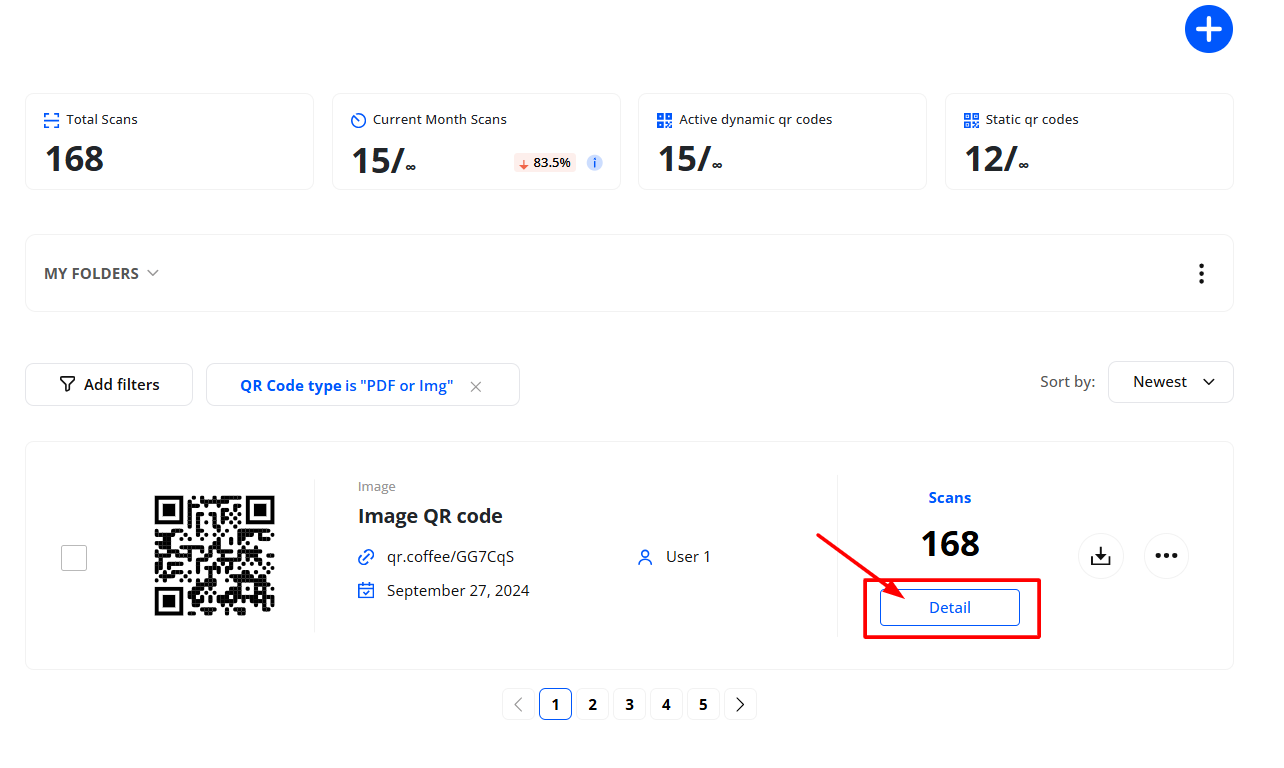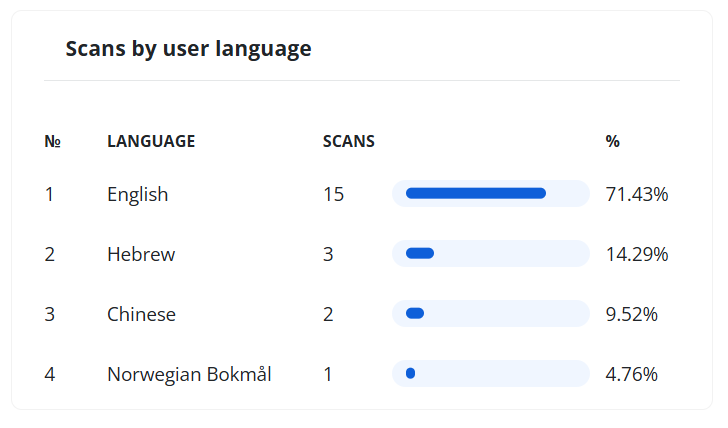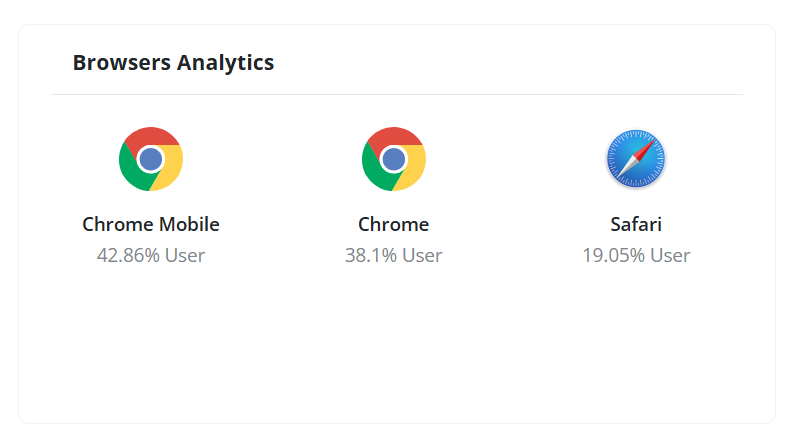Since its inception, barcodes have become a big part of marketing in the modern world. Today, the global QR code labels market is projected to reach a value of 3.5 billion USD in less than three decades. Meanwhile, businesses have started relying on QR code tracking as a means to monitor and analyze the data generated by consumers.
Over the years, modern marketing strategies have evolved due to the integration of QR codes for analysis, tracking, and social media engagement. Since they become highly beneficial, businesses of all sizes need to learn how to integrate QR code tracking and customize them to enhance customer experiences.

How Does QR Code Tracking Work?
QR code tracking is concerned with answering questions like how many times the QR code has been scanned, where, with what devices, and at what time.
QR codes come in two types: static and dynamic. Static QR code data contain fixed information, meaning once they are created, they cannot be changed. As a result, they are untrackable.
On the other hand, dynamic QR code technology is based on redirection through an intermediary server, which allows users to modify the embedded information even after the code has been printed or shared, as well as track scans. A dynamic QR code contains a short URL that directs the scanner to a tracking server. The tracking server logs the scan event, and data like the time, location, and device type are recorded. The server then redirects the user to the final destination.
Benefits of Tracking QR Code Scans
Here are some key areas where QR code tracking provides significant advantages:
- In marketing campaigns, customer feedback, product authenticity verification, inventory management, etc.
- Real-time tracking and data-driven decisions.
- Enhanced customer insights and behavior analysis.
- Better return on investment (ROI) measurement.
What Are the Most Important QR Code Metrics?
This is a list of metrics used for tracking digital tags:
- Total scans
- Unique scans (unique users).
- GPS location data (country/city)
- Scan timestamps
- Device type & operating system
- Browser information
- User language
With the services of ViralQR, you can easily obtain all this vital information about quick response scans, thus helping you collect actionable data for your campaigns.
If you track them with Google Analytics, there is also a possibility to track:
- Value of bounce rates if connected with landing pages.
- Industry-specific metrics, e.g., for retail (store visits), and B2B (form submissions).
How to Track QR Code Scans?
- Integrate with Google Analytics
- Use Urchin Tracking Module (UTM) Parameters
- Track Scan Time and Date
- Monitor Device and Browser Data
- Location-Based Tracking
With ViralQR, you can easily create a QR code with tracking and access detailed analytics to track these essential metrics and gain deeper insights into your marketing channels.
ViralQR allows you to create the following trackable QR codes:
- URL or Website
- PDF QR Code
- Image QR Code
- Reviews QR Code
- App QR Code
- vCard QR Code
- Multi URL QR Code
- Social Media QR Code
- Business page QR Code
How to Create a Trackable QR Code with ViralQR
Creating a trackable dynamic QR code is pretty simple and offers valuable analytics. Here’s how you can create yours by using ViralQR in just a few steps:
Step 1: Press “Create QR Code”: First, go to the ViralQR website. Click the “Create QR Code” button to get started.
Step 2: Choose One of the Dynamic QR Code Options: Click any one of the dynamic digital tag variants on the list.
Step 3: Set Up QR Code: Based on your preference, you are allowed to customize your data.
Additional Settings:
- Schedule: In the course of setting up a QR code, you can also select the duration of the campaign. In that process, you will be able to set up when the QR code will become operative.
- Scan limit
- Password protection
- Age-gated QR Codes
Step 4: Design QR Code: Customize the look of your QR code, including color, logo, and other designer features.
Step 5: Finish and Save/Download Your QR Code: After customizing the code, remember to click Next to save or download it.
Step 6: Test QR Code: Once the process is complete, you are free to test its effectiveness. Ensure that it redirects to a certain link that is trackable.
Now you are ready to track QR codes!
How to Access Your QR Code Metric Tracking Tool
Here is a guide on how to gain access to your metrics by using ViralQR:
Step 1: Log Into Your ViralQR Account: First, log in to your ViralQR account. If you don’t have one, you can sign up on our website.
Step 2: Get Access To Your Dashboard: After logging in, you will be redirected to your dashboard. In your dashboard, you can find the total number of scans and the current month scans.

Step 3: Find the trackable QR code

Step 4: Then, you can access the QR code statistics by pressing on Details.

Here, you will see:
- Timetable
- Number of scans for a chosen period
- Number of unique users for a chosen period

You can then see line charts for scan trends over time or for a chosen period.
By number of scans

By the number of users

Bar graphs of scans by cities with subsequent analytics

Time chart with number of scans by time of day

Scan analytics by user language

Geo-maps for location insights with subsequent analysis of scans by country

Device and OS breakdown pie charts

Browsers Analytics

How to Do QR Code Tracking with Google Analytics
QR code tracking with Google Analytics allows you to measure the users interacting with your codes by linking them to your website. You can then trace the traffic that comes from them and use it to analyze the user’s behavior.
How to Track QR Code Scans in Google Analytics in 3 Steps
Step 1: Generate URL with UTM Parameters: The first thing to do is add UTM parameters to your target URL which will allow you to effectively track in Google Analytics.
Step 2: Create a Dynamic QR Code: Ensure to select the option indicating that you are creating a dynamic QR code, so later if you want to edit the link or track the data, you will have options to do so.
Step 3: Examine With Google Analytics: Once users are redirected to the URL of the website or digital content, you can quickly analyze your user data. Check your Google Analytics dashboard to find the number of visitors that came through your QR code in Acquisition > Campaigns and analyze their behaviors.
Why a QR Code Generator with Tracking is Better Than Google Analytics for QR Code Scan Tracking?
Here are some reasons why a QR code generator with analytics ranks ahead of Google Analytics for QR code scan tracking:
Real-Time Tracking: Generators containing built-in analytics, like ViralQR, let users understand their scans, including in real-time, location-based, device types, and how frequently one code is being scanned over and over again. With Google Analytics, only insights at a website level will be drawn, and nothing will be drawn for the particular QR scan.
Trackable Data: QR code generators with tracking also permit more in-depth analysis, such as scan timestamps, numbers of unique users, device use, and geographic location. All these are not offered directly through Google Analytics.
Customization and Control: With a QR code generator, you have complete control over your QR code settings, such as limiting the number of scans or setting expiration dates, which you can’t do within Google Analytics.
QR Code Generator Integration with Google Analytics
Currently, at ViralQR, we are working on improving and expanding more Google Analytics integration capabilities so that our users will be able to make use of even more powerful tracking features in the future.
Examples of Campaigns That Could Use QR Code Tracking
The following are some examples of campaigns that benefit from code tracking:
Product Launches
You can use QR code campaigns on product packaging, brochures, or print ads to link to promotional content.
Event Promotion
Tracking QR code traffic can help you measure the success of your promotional efforts and identify the most effective channels.
Customer Feedback Surveys
Tracking the responses allows you to gather real-time insights into customer satisfaction.
💡 You also may be interested in How to Make a QR Code for a Google Form.
Educational Materials
You can track the scans that you add to your education materials to help monitor engagement and understand which materials are most popular with students.
How to Use A/B Testing to Compare QR Code Campaigns
A/B testing is a strong method for comparing the performance of multiple QR code campaigns to determine which is yielding the best results. Here’s how to set up and use A/B testing for your campaigns:
Step 1: Create Multiple QR Codes: Design two or more versions of your QR code campaign with the one element that you want to test being different on each. For example:
Version A: QR code linking to the landing page with a discount.
Version B: QR code linked to the product demo video.
Step 2: Set Up Unique Tracking for Each Version: Employ an analytics QR code generator like
ViralQR to create dynamic QR codes for each variation.
Step 3: Distribute All Your QR Codes in Different Channels or Locations: Segment your audience by publishing these two QR codes on various platforms or locations:
Place Version A in print advertisements or on in-store displays.
Place Version B on your website or email marketing campaigns.
Step 4: Monitor Performance Metrics: Track and analyze the performance of each QR code using the analytics dashboard provided by your QR code generator. Key metrics to look at include:
- Number of scans
- Conversion rates (e.g., purchases, sign-ups)
- Scan GPS location
- Time of day
- Device types used
Step 5: Analyze the Results: Compare the performance of the two QR codes to determine which version yields better results. For example, you might find that one version drives more traffic to your landing page, while the other results in higher engagement.
Step 6: Implement Insights for Future Campaigns: After you find out which variation of the campaigns works better, you can now apply the results to future optimization.
How Does QR Code Tracking Impact Marketing Analytics? Why It Is Important to Track Your Marketing Metrics
Here’s why tracking QR code scans is important:
- Measure campaign effectiveness
- Identify the most effective channels
- Understand customer demographics
- Long-term campaign analytics
Tips for Analyzing Your QR Code Tracking Data
Here are some practical tips to get the most out of your scan data:
- Focus on key metrics
- Use geo-location data for targeting
- Track engagement with landing pages
- Look for correlations with offline marketing efforts.
Amplify Your Strategy with Dynamic QR Code Tracking Insights
Here’s how tracking the performance of your dynamic QR codes can elevate your marketing efforts:
Real-Time Performance Adjustments
Dynamic QR codes let you track scans in real time to know how to tweak campaigns on the fly. If a certain code isn’t pulling in the numbers, you can adjust its destination and messaging or even limit the number of scans for optimal results throughout your campaign.
In-Depth Reporting and Analytics
Dynamic QR codes offer complete insight with effective QR code analytics, showing specific time-of-day tracking, GPS locations of device traffic, and device breakdowns to let you understand when, how often, and where these codes are being scanned.
QR Code Tracking Best Practices

Number of smartphone users in the United States who used a QR code scanner on their mobile devices from 2020 to 2025 (in millions) (Source: Statista)
A survey shows that 45% of U.S. shoppers would prefer to use QR codes to access promotional content. This shows it is a reliable front for any business or brand to explore in its marketing efforts. This makes it necessary to ensure that you have effective strategies to help you maximize the effectiveness of your tracking efforts, such as:
- Set up clear campaign objectives
- Monitor device and operating system data
- Track time of day and engagement trends
- Keep user privacy in mind
Frequently Asked Questions
How do you use QR code metrics to reach, engage, and convert your target audience?
One major function of quick response code metrics is to give information on where, when, and how your target audience interacts with your content. With this information, you can easily procure the best marketing strategy to increase engagement.
What is the difference between split / A/B testing?
Split testing compares multiple versions, while A/B testing compares just two.
Is there a limit on how many times a QR code can be scanned?
Yes, some of them have a scan limit set by the creator, after which the code becomes inactive.
What happens if a QR code is damaged or partially obscured?
If a QR code is damaged or partially obscured, it may still be readable thanks to built-in error correction. However, if the damage exceeds the error correction capacity, the code will fail to scan or lead to errors.
Do QR codes work without an internet connection?
Yes, this is possible if the QR code contains offline data.
Can QR codes be scanned from a digital screen?
Yes, they can be scanned from a digital screen, such as a smartphone or computer display.
What kind of data can I track with a QR code?
You can track data like the number of scans, unique users, scan location, time of scan, operating system, etc.
Can I track who scanned my QR code?
No, QR codes cannot track the identity of individual users.


